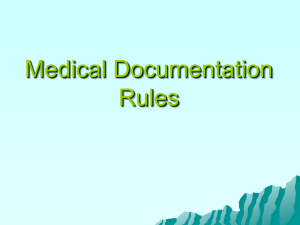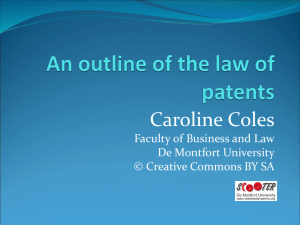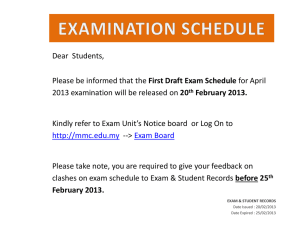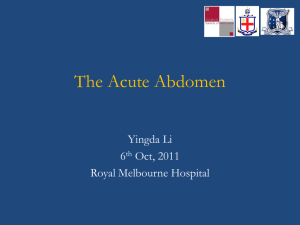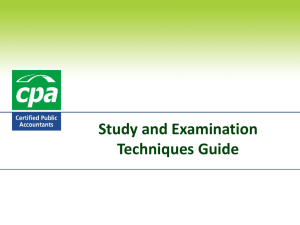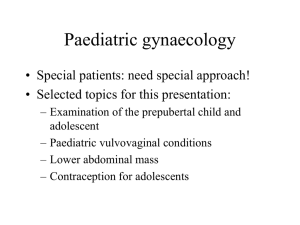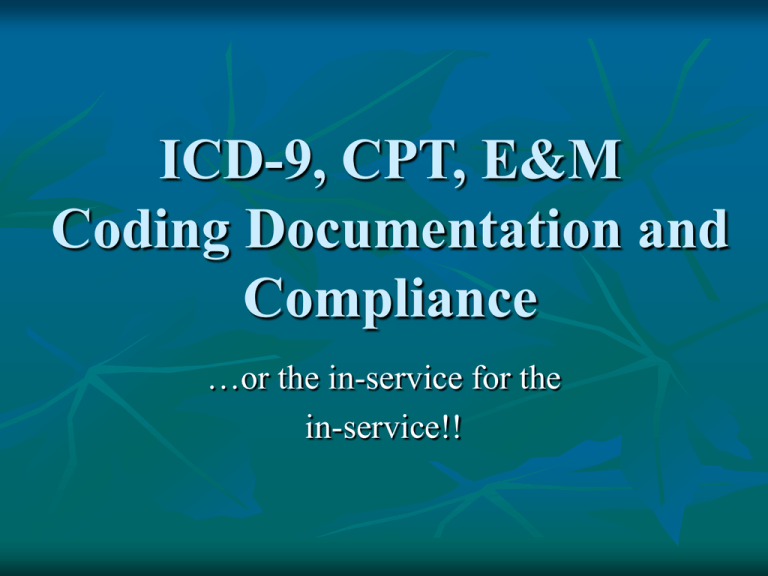
ICD-9, CPT, E&M
Coding Documentation and
Compliance
…or the in-service for the
in-service!!
…You’ve just seen a patient in your
office…
…and after the exam
You want to get paid
(After all, you need to pay mortgage, food, etc)
Insurance will pay you if…
You tell the company what you did…AND…
You tell the company why you did it
Types of “Codes”
Procedure codes
What I did during the visit
Two Types
ICD
CPT
Evaluation and Management
Why I did it
The actual diagnosis code
…and these must make sense together
ICD codes
ICD-9
ICD Codes
ICD = International Statistical Classification of
Diseases and Related Health Problems
Provides codes to classify diseases and a wide variety
of signs, symptoms, abnormal findings, complaints,
social circumstances and external causes of injury or
disease.
Every health condition can be assigned to a unique
category and given a code, up to six characters long.
Easy to understand
Allows for global (international) understanding of
information
ICD-9
(9th version- currently one in use)
001-139: Infectious and parasitic diseases
140-239: Neoplasms
240-279: Endocrine, nutritional, metabolic and immunity disorders
280-289: Blood ad blood-forming organs
290-319: Mental disorders (used by primary care and psych for research. DSM codes
are used for clinical billing by psych)
320-359: Nervous system
360-389: Sense organs
390-459: Circulatory system
460-519: Respiratory system
520-579: Digestive system
580-629: Genitourinary system
630-676: Complications of pregnancy/childbirth
680-709: Skin and subcutaneous tissues
710-739: Musculoskeletal system and connective tissue
740-759: Congenital anomalies
760-779: Certain conditions originating in the perinatal period
780-799: Symptoms, signs and ill-defined conditions
800-999: Injury and poisoning
E and V codes: External causes of injury and supplemental classification
ICD-9
Can list by disease or symptom
Get better reimbursement for more detail
Some insurances will only pay for a certain
number of visits per diagnosis
e.g., diabetes
Large book with diagnostic codes or can get on
line
http://www.icd9coding1.com/flashcode/home.j
sp
ICD-9 codes
More detail the better….
Break these down further!
Diseases of the circulatory system
(390-459)
Hypertensive disease (401-405)
(401) Essential Hypertension
(402) Hypertensive heart disease
(403) Hypertensive renal disease
(401.0) Hypertension, malignant
(401.1) Hypertension, benign
(403.91) Hypertensive renal disease, unspec., w/ renal
failure
(404) Hypertensive heart and renal disease
(405.01) Hypertension, renovascular, malignant
(405.11) Hypertension, renovascular, benign
Endocrine, nutritional and metabolic diseases,
and immunity disorders (240-279)
diseases of other endocrine glands (250-259)
Note: for 250-259, the following fifth digit can be added:
(250.x0) Diabetes mellitus type 2
(250.x1) Diabetes mellitus type 1
(250.x2) Diabetes mellitus type 2, uncontrolled
(250.x3) Diabetes mellitus type 1, uncontrolled
(250) Diabetes mellitus
(250.0) Diabetes mellitus without mention of complication
(250.1) Diabetes with ketoacidosis
(250.2) Diabetes with hyperosmolarity
(250.3) Diabetes with other coma
(250.4) Diabetes with renal manifestations
(250.5) Diabetes with ophthalmic manifestations
(250.6) Diabetes with neurological manifestations
(250.7) Diabetes with peripheral circulatory disorder
(250.8) Diabetes with other nonspecified manifestations
(250.9) Diabetes with unspecified complication
780-799: Symptoms, signs and illdefined conditions
(780) General symptoms
(780.0) Alteration of
consciousness
(780.01) Coma, nondiabetic,
nonhepatic
(780.02) Mental status
changes
(780.09) Semicoma, stupor
(780.1) Hallucinations
(780.2) Syncope
(780.3) Convulsions
(780.31) Seizures,
convulsions, febrile
(780.39) Seizures,
convulsions, other
(780.4) Dizziness/vertigo, NOS
(780.5) Sleep disturbance,
unspec.
(780.53) Hypersomnia, sleep
apnea
(780.53) Sleep apnea w/
hypersomnia
(780.58) Movement disorder,
sleep related
(780.6) Fever, nonperinatal
(780.7) Malaise and fatigue
(780.8) Sweating, excessive
(780.9) Other general symptoms
(780.92) Crying, infant,
excessive
(780.93) Memory loss
(780.94) Early satiety
CPT
Current Procedural Terminology
CPT
CPT = Current Procedural Terminology
Code Set accurately describes medical, surgical, and
diagnostic services
Designed to communicate uniform information about
medical services and procedures among physicians,
coders, patients, accreditation organizations, and
payers for administrative, financial, and analytical
purposes.
The current version is the CPT 2008.
CPT
A CPT code is a five digit numeric code that is used
to describe medical, surgical, radiology, laboratory,
anesthesiology, and evaluation/management services
of physicians, hospitals, and other health care
providers.
There are approximately 7,800 CPT codes ranging
from 00100 through 99499.
Two digit modifiers may be added when appropriate
to clarify or modify the description of the procedure.
Current Procedural Terminology
Chapter 1: Evaluation and Management Codes
(99201-99499)
Chapter 2:
Chapter 3:
Chapter 4:
Chapter 5:
Anesthesia Codes (00100-01999)
Surgery Codes (10040-69990)
Radiology Codes (70010-79999)
Pathology/Laboratory Codes (80049-
89399)
Chapter 6: Medicine Codes (90281-99199)
Appendices: Modifiers, Deleted codes
V codes: Supplemental classification
V01 Contact with or exposure to communicable diseases
V02 Carrier or suspected carrier of infectious diseases
V09 Infection with drug-resistant microorganisms
V10 Personal history of malignant neoplasm (i.e. cancer)
V16 Family history of malignant neoplasm
V17 Family history of certain chronic disabling diseases
V20 Health supervision of infant or child
V21 Constitutional states in development
V22 Normal pregnancy
V codes, cont
V23 Supervision of high-risk pregnancy
V24 Postpartum care and examination
V25 Encounter for contraceptive management
V28 Encounter for [antenatal] screening of mother
V29 Observation and evaluation of newborns for suspected
conditions not found
V30 Single liveborn
V31 Twin birth mate liveborn
V48 Problems with head neck and trunk
V49 Other conditions influencing health status
V50 Elective surgery for purposes other than remedying
health states
V51 Aftercare involving the use of plastic surgery
V codes, cont
V56 Encounter for dialysis and dialysis catheter care
V57 Care involving use of rehabilitation procedures
V58 Encounter for other and unspecified procedures and aftercare
V60 Housing, household and economic circumstances
V64 Persons encountering health services for specific procedures not
carried out
V65 Other persons seeking consultation
V66 Convalescence and palliative care
V67 Follow-up examination
V68 Encounters for administrative purposes
V69 Problems related to lifestyle
V70 General medical examination
V71 Observation and evaluation for suspected conditions not found
V80 Special screening for neurological eye and ear diseases
V81 Special screening for cardiovascular respiratory and genitourinary
diseases
V85 Body mass index
Relationship between CPT and ICD-9
The critical relationship between an ICD-9 code
and a CPT code is that the diagnosis supports the
medical necessity of the procedure.
Since both ICD-9 and CPT are numeric codes, health
care consulting firms, the government, and insurers
have all designed software that compares the codes
for a logical relationship.
For example, a bill for CPT 31256, nasal/sinus endoscopy
would not be supported by ICD-9 826.0, closed fracture of
a phalanges of the foot.
Such a claim would be quickly identified and rejected.
…trivia for boards…
Health Care Financing Administration (HCFA)
Diagnosis Codes
CPT
Updated Annually
Level II (national)
ICD – 9
Creates medical necessity
Level I
Common Procedural Coding System (HCPCS)
HCPCS (A-V)
Alphanumeric System
Level III (State)
Local Codes (W-Z)
E & M Coding
Evaluation and Management
Most confusing for physicians
What are E&M Codes?
The Evaluation & Management (E&M) codes are a subset of the CPT codes.
Can be used by all privileged providers
Describes:
Complexity of care provided to a patient for non-procedural
visits.
The place of service (inpatient or outpatient)
The type of service (new vs. established, consult, preventive,
ER, critical care, etc)
Defined by 3 components
The patient history
The physical examination
Medical decision making
Why Code?
REIMBURSEMENT
Third Party Payers/Insurance Agencies
Prospective Payment Systems (PPS)
Over coding = Fraud
Under coding = Lost Revenue
What Do Coders Look For?
Professional Coders in your office or from
insurance companies have been trained to
match documentation in charts to the billing
information
It is the Content, not the volume, of
documentation that determines your E&M
code!
What Do Coders Look For?
Every patient encounter should be legible and
include:
Date of Encounter
Reason for the visit (chief complaint)
Appropriate history of present illness
An exam when necessary or appropriate; i.e. a new patient
(consistency and problem pertinent)
Review of lab, x-ray, other ancillary services when
appropriate
Assessment
Plan of care/Treatment options
Provider signature
Why is Documentation Important?
The documentation must support the E&M code you
select.
Your documentation must also support the medical
necessity of the services provided.
The use of “Follow-up” is insufficient documentation
as it does not indicate medical necessity.
The first step is to clearly document the reason for every
visit – the chief complaint.
However it is acceptable to document “Follow-up for
_____”.
“If it isn’t documented, it wasn’t done!”
Patient Type
New vs. Established
Consult
Inpatient vs. Outpatient
New vs. Established
New patient
Any patient who has not received professional services,
within the previous 36 months, from a provider within the
same group, of the same specialty
Same group practice: One Federal Tax ID number for all providers,
if more than one Federal Tax ID, can consider the patient new
e.g., current practice seen in OLBH ER and Outreach offices
Professional Services: Phone call, prescription, hospital or office
visit, etc.
Specialty Issue: Optional if one federal Tax ID is shared by
practitioners of other specialties (e.g., surgeon and FP)
** DO’s and MD’s of the same specialty DO NOT differ even if OMT is offered by the DO
Average and Recommended Code
Distributions
60
50
40
Medicare
Recommended
30
20
10
0
99211 99212 99213 99214 99215
The difference in the bell
curves represents loss in
physician income!!
Determining the Correct E&M Code
There are three key components to consider when selecting the
appropriate E&M:
History
Exam
Medical Decision Making (MDM)
All three components must be documented for a new patient
(new to clinic or not seen within the past three years). Indicate
in CC if patient is new.
Only two of the three components must be documented for
established patients (seen within the past three years).
E&M selection should never be based on the allotted
time on the appointment schedule!
Determining the Correct E&M Code
To determine the correct level E&M code,
consider the complexity of your patient’s
condition and your medical decision making,
then support that level of complexity with your
documentation of history and/or exam.
Remember:
For a new clinic patient, initial consult, initial inpatient visit or ED
encounter you must document all three key components
history, exam and your medical decision making.
Defining Levels of E&M Services
7 components
History
Examination
Medical Decision Making
Counseling
Coordination of care
Nature of Presenting Problem
Time
The Medical History
History
Also has several components to determine
“complexity” or “type”
History of Present Illness (HPI)
Review of Systems (ROS)
Past Family and/or Social History (PFSH)
The extent of history is dependent on clinical
judgment and the nature of the presenting problem.
The four types of History include: Problem focused,
Expanded Problem Focused, Detailed and
Comprehensive.
History of Present Illness
History – Chief Complaint
Chief Complaint Required
The CC is usually stated in the patient’s own
words.
concise statement that describes the symptom,
problem, condition, diagnosis, or reason for the
patient encounter.
For example, patient complains of upset stomach,
aching joints, and fatigue
Cannot be the words “follow up” alone
History – History of Present Illness
Two types of HPI
Brief, which includes documentation of one to
three HPI elements.
In the following example, three HPI elements –
location, severity, and duration – are documented:
CC: A patient seen in the office complains of left ear
pain.
Brief HPI: Patient complains of dull ache in left ear over
the past 24 hours.
History – History of Present Illness
Extended, which includes documentation of at
least four HPI elements or the status of at least
three chronic or inactive conditions.
In the following example, five HPI elements –
location, severity, duration, context, and modifying
factors – are documented:
Extended HPI: Patient complains of dull ache in left ear
over the past 24 hours. Patient states he went swimming
two days ago. Symptoms somewhat relieved by warm
compress and ibuprofen.
History Components
Location
Area of body, localized, unilateral, bilateral, fixed,
migratory, radiation, referred
Quality
Specific pattern, sharp, dull, throbbing, stabbing, constant,
intermittent, acute, chronic, stable, improving, worsening
Severity
Laceration as jagged or straight
Sore throat as scratchy
Pain scale, “compared to”, observation by physician
(discomfort, wincing)
Duration
History Components
Timing
Context
Associated with activity, improves with activity, etc
Modifying factors
Onset of problem or symptom and progression, recurrent, comes and
goes, worsens or improves
Steps the patient has taken to alleviate symptoms, what exacerbates
symptoms, is helped by, is hindered by
Associated signs/symptoms
Clinical impressions direct physician questioning
Specific symptoms (weakness, headache with injury)
Generalized symptoms, chills, fever, “pertinent positives and negatives”
History Guidelines
HPI must be documented by the physician
ROS and/or PFSH can be recorded by
ancillary staff
Physician must supplement or confirm the
information
If obtained at a prior visit, do not need to re-record.
Can review and update
Describe new information
Note date and location of earlier information
History Guidelines
If unable to obtain a history
Describe patient’s medical condition or
circumstance which precludes obtaining a history
Review of Systems
Review of Systems
Definition
An inventory of body systems obtained through a series of questions
seeking to identify signs and/or symptoms that the patient may be
experiencing or has experienced
The following “systems” are recognized:
Constitutional (fever, weight loss)
Eyes
Ears, nose, mouth throat
Cardiovascular
Respiratory
Gastrointestinal
Musculoskeletal
Integumentary (skin and/or breast)
Hematologic/Lymphatic
- Psychiatric
- Endocrine
- Neurological
- Allergic/Immunologic
Review of Systems
Three categories of review
Problem Pertinent
ROS inquires about the system directly related to the
problem(s) identified in the HPI
Both positive responses and pertinent negatives should be
documented
In the following example, one system – the ear – is
reviewed:
CC: Earache.
ROS: Positive for left ear pain. Denies dizziness,
tinnitus, fullness, or headache.
Review of Systems
Extended
ROS inquires about the system directly related to HPI
AND a limited number of additional systems
2-9 systems which are documented
In the following example, two systems – cardiovascular
and respiratory – are reviewed:
CC: Follow up visit in office after cardiac catheterization.
Patient states “I feel great.”
ROS: Patient states he feels great and denies chest pain,
syncope, palpitations, and shortness of breath. Relates
occasional unilateral, asymptomatic edema of left leg.
Review of Systems
Complete
ROS inquires about the system directly related to the
HPI AND all other body systems
At least 10 body systems must be documented
Those systems w/pertinent +or- responses must be individually
documented, however for the remaining systems, “all other
systems are negative” is permissible
Review of Systems
In the following example, 10 signs and symptoms are
reviewed:
CC: Patient complains of “fainting spell.”
ROS:
Constitutional: weight stable, + fatigue.
Eyes: + loss of peripheral vision.
Ear, Nose, Mouth, Throat: no complaints.
Cardiovascular: + palpitations; denies chest pain; denies calf pain,
pressure, or edema.
Respiratory: + shortness of breath on exertion.
Gastrointestinal: appetite good, denies heartburn and indigestion.
+ episodes of nausea. Bowel movement daily; denies constipation or loose
stools.
Urinary: denies incontinence, frequency, urgency, nocturia, pain, or
discomfort.
Skin: + clammy, moist skin.
Neurological: + fainting; denies numbness, tingling, and tremors.
Psychiatric: denies memory loss or depression. Mood pleasant.
Past Medical History
Medical
Family
Social
History - PFSH
Past History
Family History
Past experience with illnesses, operations, injuries
and treatments
Review of medical events in patients family,
including hereditary disease
Social History
Age appropriate review of past and current
activities
History - PFSH
Pertinent
review of the history areas directly related to the
problem(s) identified in the HPI.
Must document one item from any of the three history
areas.
In the following example, the patient’s past surgical
history is reviewed as it relates to the current HPI:
Patient returns to office for follow up of coronary artery
bypass graft in 1992. Recent cardiac catheterization
demonstrates 50 percent occlusion of vein graft to obtuse
marginal artery.
History - PFSH
Complete
A review of two or all three of the areas,
depending on the category of E/M service.
Requires a review of all three history areas for
services that, by their nature, include a
comprehensive assessment or reassessment of the
patient.
A review of two history areas is sufficient for other
services.
History - PFSH
At least one specific item from each of the history
areas must be documented for the following
categories of E/M services:
Office or other outpatient services, new patient;
Hospital observation services;
Hospital inpatient services, initial care;
Consultations;
Comprehensive Nursing Facility assessments;
Domiciliary care, new patient; and
Home care, new patient.
History - PFSH
Does NOT need to be re-recorded
Record new information only
“No change” PFSH can be documented
History Algorithm
History Type
HPI
ROS
PFSH
Problem Focused Brief
(1 point)
None
None
Expanded
Brief
Problem Focused
(2 points)
Detailed (3
Extended
points)
Comprehensive
Extended
(4 points)
Problem
pertinent
None
Extended
Pertinent
Complete
Complete
Physical Examination
Physical Exam
Looked at either by
Body Areas
Organ Systems
Physical Exam
Body areas recognized:
Head (including face)
Neck
Chest, including breast and axillae
Abdomen
Genitalia, groin, buttocks
Back (including spine)
Each extremity (separately)
Physical Exam
Organ systems recognized
Constitutional
Eyes
ENT, Mouth
Cardiovascular
Respiratory
GI
GU
Musculoskeletal
Skin
Neurologic
Psychiatric
Hematologic; Lymphatic; Immunologic
The general multi-system exam should include findings of at
least 8 of the above 12 organ systems
Documentation of Examination
Make sure you note specific abnormal or
relevant findings of affected body areas or
organ systems
Brief statement indicating negative or normal
is sufficient for unaffected or asymptomatic
systems
Describe abnormal or unexpected findings of
asymptomatic areas or organs
Physical Examination
Type
Either this
Or this
Problem Focused (1
point)
< 1 organ system/Body area
1-5 bulleted elements
Expanded Problem
Focused (2 points)
2-4 Organ Systems/Body
areas
> 6 Bulleted Elements
Detailed Exam (3
points)
5-7 Organ Systems/Body
Areas
> 2 bulleted elements
from 6 areas or
> 12 bullets from > 2
areas
Comprehensive Exam
(4 points)
> 8 organ systems/body areas
Complete single system
examination or
> 2 bulleted elements
from 9 areas
Physical Examination
Type of Examination Description
Problem Focused
A limited examination of the affected body area or
organ system.
Expanded Problem
Focused
A limited examination of the affected body area or
organ system and any other symptomatic or related
body area(s) or organ system(s).
Detailed
An extended examination of the affected body area(s)
or organ system(s) and any other symptomatic or
related body areas(s) or organ system(s).
Comprehensive
A general multi-system examination OR complete
examination of a single organ system and other
symptomatic or related body area(s) or organ
system(s).
Physical Examination
General Multi-System Examinations
TYPE OF
EXAMINATION
DESCRIPTION
Problem Focused
Include performance and documentation of 1 - 5
elements identified by a bullet in 1 or more organ
system(s) or body area(s)
Expanded Problem
Focused
Include performance and documentation of at least 6
elements identified by a bullet in 1 or more organ
system(s) or body area(s).
Physical Examination
General Multi-System Examinations
TYPE OF
EXAM
DESCRIPTION
Detailed
Include at least 6 organ systems or body areas. For each system/area
selected, performance and documentation of at least 2 elements
identified by a bullet is expected. Alternatively, may include
performance and documentation of at least 12 elements identified by a
bullet in 2 or more organ systems or body areas.
Comp.
1997 Documentation Guidelines for Evaluation and Management
Services: Include at least 9 organ systems or body areas. For each
system/area selected, all elements of the examination identified by a
bullet should be performed, unless specific directions limit the content
of the examination. For each area/system, documentation of at least 2
elements identified by bullet is expected.
1995 Documentation Guidelines for Evaluation and Management
Services: Eight organ systems must be examined. If body areas are
examined and counted, they must be over and above the 8 organ
systems.
Exam Bullets
Constitutional
Eyes
3 vital signs
General appearance
Inspection of Conjunctiva and Lids
Examination of Pupils and Iris (PERLA)
Ophthalmoscopic discs and posterior segments
Ears, Nose, Mouth and Throat
External appearance of Nose and Ears
Otoscopic Examination
Assessment of Hearing
Inspection of Nasal Mucosa/Septum
Examination of oropharynx
Exam Bullets
Neck
Examination of Neck
Examination of Thyroid
Respiratory
Assessment of respiratory effort
Percussion of Chest
Palpation of Chest
Auscultation of Lungs
Exam Bullets
Cardiovascular
Palpation of PMI
Auscultation of the Heart
Assessment of Lower Extremity Edema
Examination of Carotid Artery
Examination of abdominal aorta
Examination of femoral pulse
Examination of pedal pulse
Chest (breasts)
Inspection of breasts
Palpation of breasts and axillae
Exam Bullets
Gastrointestinal (abdomen)
Examination with notation of masses or tenderness
Examination of liver and spleen
Examination for presence/absence of hernias
Examination of anus, perineum, rectum, including
sphincter tone, hemorrhoids
Obtain stool for occult blood
Genitourinary (male)
Examination of scrotal contents
Examination of Penis
DRE prostate
Exam Bullets
Genitourinary (female)
Examination of external genetalia
Examination of urethra
Examination of bladder
Examination of cervix
Examination of uterus
Examination of adenexa
Lymphatic
Palpation of lymph nodes in two or more areas
Neck, axillae, groin, other
Exam Bullets
Musculoskeletal
Examination of gait and station
Examination of joints, bones and muscles of one or more of
the following 6 areas
Head and Neck
Spine, ribs and Pelvis
Right Upper Extremity
Left Upper Extremity
Right Lower Extremity
Left Lower Extremity
Examination includes…Inspection and/or palpation with
notation of any misalignment, asymmetry, crepitation, etc;
range of motion with notation of pain, crepitation;
assessment of stability; assessment of muscle strength
Exam Bullets
Skin
Neurologic
Examination of skin and subcutaneous tissue
Palpation of skin and subcutaneous tissue
Test cranial nerves with notation of deficit
Examination of DTR
Examination of sensation
Psychiatric
Description of judgment and insight
Brief assessment of mental status
Medical Decision Making
Determination of Medical Decision
Making
Based upon
Number of diagnoses or management options
Amount and complexity of data
Overall risk
Medical Decision Making
(MDM) refers to the complexity of determining a
diagnosis and/or the selection of a treatment option.
Measured by documentation of the following:
Number of diagnoses and/or management options that must
be considered.
Amount and/or complexity of data to be reviewed.
Risk of complications, morbidity and/or mortality, and comorbidities.
Four types
Straightforward, Low Complexity, Moderate Complexity,
and High Complexity.
Documentation to Support
Complexity
Consider the following for risk
Chronic illness(es)
Well controlled
Mild exacerbation
Severe exacerbation
Acute illness
Uncomplicated like allergic rhinitis
With systemic symptoms like pneumonitis
Medical Decision Making
Diagnoses/Management Options
Max of 4 points
Problem Categories
Number of
Problems
Self Limited/minor
Max of 2
Possible Score
Points
1
Established Problem – stable or
improving
1
Established problem – worsening
2
New problem (no further work up)
New problem (work up needed)
Max of 1
3
4
Documentation to Support
Complexity
Consider the following…
Did you order/review labs?
Did you order/review X-rays, US, MRI
Did you order/review any other testing
Did you visualize image, tracing, or specimen
Did you review or summarize old records
Must document this on the record
…old records reviewed which noted ….
Medical Decision Making
Amount and Complexity of Data
Max of 4 points
Type of Data
Check if Possible
Done
Points
Review/Order tests (8xxxx clinical)
1
Review/order tests (7xxxx radiology)
1
Review/order tests (9xxxx medicine)
1
Discuss test results with performing
physician
2
Independent review of tracing, specimen,
image
2
Decision to obtain medical records
1
Review, summarize old records and/or obtain
history
2
Score
Table of Risk
Level of risk
Presenting problem(s)
Diagnostics ordered
Management options
Minimal (1
point)
One self-limited/minor problem
(e.g., URI)
Lab tests requiring venipuncture
CXR
EKG
Urinalysis
Rest
Gargles
Ace wrap
Low (2 points)
2+self limited/minor problems
1 stable/chronic illness
Acute uncomplicated illness/injury
Physiologic tests not under stress (pulm. Function)
Non-cardiac imaging w/barium
Lab requiring arterial puncture
Skin biopsy
Over the counter drugs
Minor surgery w/no identified
risk
PT/OT
IV fluids w/o additives
Moderate (3
points)
1+chronic illnesses with mild
progression, or side effects of
treatment
2+ stable chronic illnesses
Undiagnosed new problem
w/uncertain prognosis
Acute illness with systematic
symptoms
Acute uncomplicated injury
Physiologic test under stress
Diagnostic endoscopy w/no risk factors
Deep needle or incisional biopsy
Obtain fluid from body cavity
Minor surgery w/risk factors
Elective major surgery w/no risks
Prescription drug management
IV with additives
High (4 points)
1+ chronic illness with severe
exacerbation or side effects of
treatment
Acute/chronic illness that poses a
threat to life/bodily function
Abrupt change in neurologic status
Cardiovascular imaging w/contrast w/risk factors
Cardiac electrophysiological tests
Diagnostic endoscopies w/identified risk factors
Elective major surgery w/risk
factors
Emergency major surgery
Parenteral controlled substances
DNR due to poor prognosis
Medical Decision Making
The HIGHEST level of ANY ONE of the three
aspects of a medical decision making will
determine the overall level chosen
Medical Decision Making
Final Medical Decision Making
2 of 3 rule
Decision
Making
Straight
Forward
Low
Diagnosis
&/or
Management
Options
Minimal (1) Limited (2) Multiple (3) Extensive
(> 4)
Amount of
Data
Reviewed
Minimal (1) Limited (2) Multiple (3) Extensive
(> 4)
Table of Risk Minimal (1) Low (2)
Moderate High
Moderate
(3)
High (4)
Defining Levels of E&M Services
7 components
History
Examination
Medical Decision Making
Counseling
Coordination of care
Nature of Presenting Problem
Time
Counseling and
Coordination of Care
Discussion with patient or family concerning
one or more of the following:
Diagnostic results
Prognosis
Risk & benefits of management options
Instruction for management
Compliance
Time…as another factor
Appropriate in cases where counseling and/or
coordination of care dominates (>50%) of the
patient and/or family encounter
Documentation requirements
Total face to face time or encounter
Total counseling/coordination time
Content of counseling/coordination
Time based billing…example
cc: Depression
Hx cc: 59 y/o female w/depression and anxiety.
Denies suicidal ideations. Hx ativan use in past
Exam: vitals (list)
A/P: Depression. Had long discussion w/patient and
counseled him on exacerbating factors and treatment
options. Rx ordered (list)
Total visit time 25 minutes, counseling time 15
minutes
Summing Up Your
Services
Billing the Correct Code…
The Constants of Coding
3 of 3 rule
Go to the lowest component
i.e., 2,3,4 = 2
3,3,4 = 3
Used for new patient, initial consults, initial hospital care
and emergency department visits
2 of 3 rule
Go to the middle component
2,3,4 = 3
3,3,4 = 3
Used for established patient, subsequent hospital f/u, f/u
consult
New vs. Established Patient
New Patient
All key components must meet or exceed the stated
requirements to qualify for a particular level
Established Patient
Two key components must meet or exceed stated
requirements to qualify for a particular level
Documentation Requirements
New Patient Office Visit
3 of 3 rule
Level of History
Service
Examination
Medical Decision
Making
99201
Problem focused
Problem focused
99202
99203
Expanded
problem focused
Detailed
Expanded
problem focused
Detailed
Straight forward
complexity
Straight forward
complexity
Low complexity
99204
Comprehensive
Comprehensive
Moderate complexity
99205
Comprehensive
Comprehensive
High complexity
Documentation Requirements
New Patient Office Visit
3 of 3 rule
Level of History
Service
Examination
Medical Decision
Making
99201
Problem focused
Problem focused
99202
99203
Expanded
problem focused
Detailed
Expanded
problem focused
Detailed
Straight forward
complexity
Straight forward
complexity
Low complexity
99204
Comprehensive
Comprehensive
Moderate complexity
99205
Comprehensive
Comprehensive
High complexity
Documentation Requirements
New Patient Office Visit
3 of 3 rule
Level of History
Service
Examination
Medical Decision
Making
99201
Problem focused
Problem focused
99202
99203
Expanded
problem focused
Detailed
Expanded
problem focused
Detailed
Straight forward
complexity
Straight forward
complexity
Low complexity
99204
Comprehensive
Comprehensive
Moderate complexity
99205
Comprehensive
Comprehensive
High complexity
Documentation Requirements
New Patient Office Visit
3 of 3 rule
Level of History
Service
Examination
Medical Decision
Making
99201
Problem focused
Problem focused
99202
99203
Expanded
problem focused
Detailed
Expanded
problem focused
Detailed
Straight forward
complexity
Straight forward
complexity
Low complexity
99204
Comprehensive
Comprehensive
Moderate complexity
99205
Comprehensive
Comprehensive
High complexity
Established Patient CPT E&M Guidelines
2 of 3 rule
Code
History
Physical Exam Medical Decision
making
Time
99211
Nursing service N/A
only
Nursing order
5
99212
Problem
Focused (1)
Problem
Focused (1)
Straight forward (1)
10
99213
Expanded
Problem
Focused (2)
Expanded
Problem
Focused (2)
Low Complexity (2)
15
99214
Detailed (3)
Detailed (3)
Moderate Complexity
25
99215
Comprehensive Comprehensive High Complexity (4)
(4)
(4)
40
Established Patient CPT E&M Guidelines
2 of 3 rule
Code
History
Physical Exam Medical Decision
making
Time
99211
Nursing service N/A
only
Nursing order
5
99212
Problem
Focused (1)
Problem
Focused (1)
Straight forward (1)
10
99213
Expanded
Problem
Focused (2)
Expanded
Problem
Focused (2)
Low Complexity (2)
15
99214
Detailed (3)
Detailed (3)
Moderate Complexity (3)
25
99215
Comprehensive Comprehensive High Complexity (4)
(4)
(4)
40
Established Patient CPT E&M Guidelines
2 of 3 rule
Code
History
Physical Exam Medical Decision
making
Time
99211
Nursing service N/A
only
Nursing order
5
99212
Problem
Focused (1)
Problem
Focused (1)
Straight forward (1)
10
99213
Expanded
Problem
Focused (2)
Expanded
Problem
Focused (2)
Low Complexity (2)
15
99214
Detailed (3)
Detailed (3)
Moderate Complexity (3)
25
99215
Comprehensive Comprehensive High Complexity (4)
(4)
(4)
40
Inpatient Codes
Follow 3 of 3 rule
Inpatient Services and Observation
Inpatient Consults
Inpatient follow ups follow the 2 of 3 rule
Other Medical Services
General Consultant
Pre/Post Operative Consults
Definition of Consultation
Type of service provided by a physician whose
opinion ad advice regarding evaluation and/or
management of a specific problem is requested
by another physician or other appropriate
source.
Consultation Services
Documentation MUST include
Request for consultation documented in the
medical record
Reason for consultation (medical necessity)
Report- Consultant’s opinion, advice and
evaluation of the patient (this MUST be
communicated back to the requesting physician)
Have separate initial coding
Follow up visits use established patient visits
Preoperative Consultation
Must request opinion or advice regarding a
specific problem
Request and need for consult must be
documented in the medical record
Any services ordered or performed must be
documented
Consultant’s opinion, advice and evaluation of
the patient must be communicated back to the
requesting surgeon
Preoperative Clearance
ICD-9 diagnosis codes
V72.81 Preoperative cardiovascular examination
V72.82 Preoperative op respiratory examination
V72.83 Other specified preoperative examination
V72.84 Preoperative examination, unspecified
V72.85 Other specified examination
Must supplement with sigh/symptom/dx codes
Must also include surgical indication (eg, cataracts)
Rules for Consultation
99241-99275
Opinion or advise regarding E&M of a specific
problem is requested
Documented request from appropriate source is
required (if patient generated for 99271-99275)
Written report sent to referring provider (a letter for
an outpatient)
Initiation of care at time of consult is acceptable
Post-op consult by provider performing pre-op
clearance should use subsequent hospital codes or
established office visit codes
New outpatient and consultative CPT E&M
Guidelines
3 of 3 rule
Confirm Initial
New
Consult consult patient
History
Physical Exam Medical
Decision
Making
Time
99271
99241
99201
Problem Focused
(1)
Problem
Focused (1)
Straight
forward (1)
10
99272
99242
99202
Expanded prob.
focused (2)
Expanded prob.
focused (2)
Straight
forward (1)
20
99273
99243
99203
Detailed (3)
Detailed (3)
Low Complex
(2)
30
99274
99244
99204
Comprehensive (4) Comprehensive
(4)
Moderate
45
Complexity (3)
99275
99245
99205
Comprehensive (4) Comprehensive
(4)
High
Complexity
60
Coding Examples
Documentation Requirements
Established Patient Office Visit
Level of History
service
Examination
Medical decision
making
99211
Nursing service only
Nursing order
99212
Problem focused
Problem focused
Straight forward
complexity
99213
Expanded problem
focused
Expanded problem
focused
Low complexity
99214
Detailed
Detailed
Moderate complexity
99215
Comprehensive
Comprehensive
High complexity
Example 99211
Non-physician visit
Patient Calls Advice Nurse with Possible UTI
Patient brings and drops-off UA
Nurse processes UA
You (Doctor/PA/NP) review and find UTI
Nurse calls in antibiotics and documents in Chart
Blood Pressure Check
Example 99212
4y/o female with fever and ear pain
Established Patient: 2 of 3 required
History: 1-2 HPI
Exam: 1-5 elements
Medical Decision Making: 1 self limited minor
problem
Example 99212
4y/o female with fever and ear pain
History
Exam
Fever 101
Left ear 3 days
Injection with redness and drainage of tympanic membrane
Pharynx red, no exudates
+ anterior cervical nodes
Lungs clear
Heart rrr
Medical Decision Making
OM – Prescription Antibiotics
Fever control
Recheck in 2 weeks
Example 99213
4 y/o female with fever and ear pain
History:
1-3 HPI elements …AND
ROS
Exam: 6-11 elements
Medical Decision Making:
2 self-limited or minor problems …OR
1 new problem plus low risk
Example 99213
4 y/o female with fever and ear pain
History:
Fever and Ear pain for 3 days
ROS
PFSH
NKA/Immunization/passive smoking/any chronic meds
Exam
Cough/sinus congestion, sore throat, vomiting and diarrhea
3 vitals (weight, temp, BP)
Left TM red, pharynx red, tender nodes, neck supple, lungs clear, heart
regular, abdomen non-tender
Medical Decision Making:
LOM
Antibiotics/Fever Control
Recheck in 2 weeks
Call if worse
Example 99214
58 y/o male at 3 month check up
Detailed history
Detailed exam
Extended HPI
Extended ROS
One element PFSH
12 exam elements from at least 2 systems
Moderate Complexity
2 of the following: Multiple dx; Moderate amount
and complexity of data; Moderate risk
Example 99214
58 y/o male at 3 month check up
History
HTN; DM; DJD; vision exam UTD; (-) HA; (-) SOB; (-) CP; (-)
NVDC; (-) Hematochezia; (-) Nocturia
PFSH
Detailed exam
12 exam elements from at least 2 systems
Medical Decision Making
Unchanged from prior exam
EKG, Pulse Oximetry; UA, Rapid Strep
Review of CXR
Prescriptions written
Document Procedures
Document OMM
OMT Billing
OMT codes
These are nonallopathic lesions, not elsewhere
classified.
CPT codes 98925 – 98929
ICD codes 739.0 – 739.9 depending on body
region
Will be discussed at separate lecture in detail
Other Billable Services
Other Billable Services
Injections/Immunizations
Smoking Cessation
Visit and procedures
Injections/Immunizations
90471 is for first administration
90472 is for EACH additional administration
Cannot report if patient brings their own
supply
Cannot bill 99211 (nursing service) if only
injection given
Must provide separately identifiable service
e.g., get vital signs
Smoking Cessation
Document that you told patient to stop
smoking
99406 Greater than 3 minutes, up to 10 minutes
99407 Greater than 10 minutes
Other Billable Services
Digital Rectal Exam for Prostate Cancer Screening
Visual Acuity Exam (Snellen Chart)
G0102
99173
Needle Sticks!!
96150 – e.g., when an occupational health nurse sees a patient due to a
needle stick he/she can code this encounter as 99499 E/M and 96150
CPT with the applicable ICD-9 primary for the wound and a
secondary ICD-9 code of the External cause.
Billing an office Visit and a
Procedure
Procedure must be a separate service from the
evaluation and management service
Modifier 25 should be added to the evaluation
and management service to identify that it is a
separate service
Other Coding Opportunities
Modifiers
22 Unusual procedural service
25 significantly, separately identifiable E&M
service by the same physician on the same day of
the procedure or other service
e.g., patient comes in with sinus infection – you do
OMT “cause it will help” vs. patient coming in
specifically for OMT
32 Mandated by 3rd party (HMO)
51 Multiple Procedures
Other Miscellany
Other…
If you see a patient and admit directly to a
hospital, you should submit only the hospital
code.
Critical Care Codes
Use appropriate E&M code if < 30 minutes
99291
First 30-74 minutes of evaluation and management
99292
Each additional 30 minutes (can round up after 15
minutes)
e.g., 105-134 minutes = 99291 x 1 and 99292 x 2
Prolonged Care Codes
Threshold time is 30 minutes over the time
component allotted for the E&M code
Outpatient
Inpatient
99354-99355
Face to face time
99356-99357
Inpatient or outpatient office/floor/unit time without direct
patient contact
99358-99359
e.g., IV running for rehydration in your office for 1 hour
Other Coding Opportunities
99050
After Hours
99052
Services Provided between 11pm and
8am
99054
Sundays/Holidays
99024
Post op follow up in Global Period
99058
Office services on Emergent basis
99082
Unusual Travel (transport/escort)
99090
Analysis of Data Stored on Computer
For Further Information
Evaluation and Management Services Guide AMA

